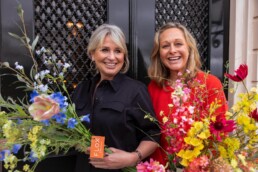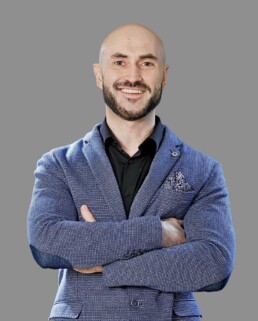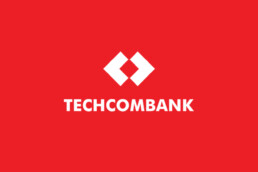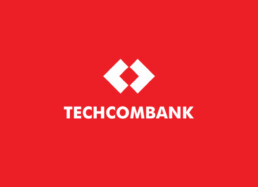From scratch to strategy: Sirikit Huibers’ CX transformation at Greenchoice
From scratch to strategy: Sirikit Huibers’ CX transformation at Greenchoice
For the past three and a half years, Sirikit Huibers has led a quiet CX revolution at Greenchoice. As Customer Experience Lead, she built the foundation for a company-wide transformation—aligning customer understanding, unifying feedback measurement, and embedding a culture of continuous improvement. Her story is one of strategic patience, grassroots energy, and a deep belief in the power of collaboration.
Who is Sirikit Huibers?
Sirikit’s customer mindset was shaped early. Spending summers working at her parents’ bungalow park at Ko Samui in Thailand, she learned first-hand how to serve with empathy and authenticity. “That’s where I learned how to offer excellent service by staying close to yourself,” she explains. Her career later spanned housing and pensions, with CX roles at Stadgenoot and APG. “That’s when the flame really lit for me,” she says, recalling the first time she co-created a service blueprint for both customer and employee journeys.
At Greenchoice, she stepped into a role that didn’t yet fully exist—tasked with shaping a CX approach from the ground up.


Understanding the brand: Greenchoice
Greenchoice is one of the Netherlands' top five energy providers, serving over 650,000 customers with a strong focus on sustainable energy. A former scale-up turned grown-up, Greenchoice still has a strong sense of ownership across the company—and a culture of autonomy that doesn’t naturally lend itself to top-down change. That made Sirikit’s work both exciting and complex.
The challenge: shaping a CX foundation in a decentralized culture
When Sirikit joined, CX was fragmented. “There were different customer profiles, different KPIs, and people were calling process maps ‘customer journeys,’” she recalls. Multiple teams were doing good work—but without shared direction.
Adding to the challenge was the company’s culture. With roots in start-up energy, everyone felt ownership. That meant imposing a strategy from above wasn’t an option. “We realized a bottom-up strategy would fit best,” Sirikit says. Her first step wasn’t to announce a grand vision, but to create practical tools that empowered colleagues to get started on their own.
The solution: bringing structure, step by step
Sirikit’s transformation approach rested on aligning the basics—shared customer profiles, a central feedback measurement framework, CX principles, and a strong internal network to keep things moving.
- One shared customer view
One of the early breakthroughs was aligning on a single set of customer profiles. “I found it incredible that people on the website team said they had a totally different customer than the service team,” Sirikit says. With the help of a research agency and colleagues from across departments, they mapped out overlapping insights in structured workshops. The result was a clear, shared framework based on the Mentality profiles, with simple names like the world-improver or the convenience-seeker.
“We introduced them in a big virtual session during the tail end of COVID—then played a round of petje op petje af to test the knowledge on the customer profiles and to make it stick.”
- Fixing fragmented feedback
Greenchoice had customer feedback pouring in—just not in a way that made sense. Sirikit brought all measurements into a single dashboard. That dashboard made it painfully clear: different scales, metrics, and formats meant results weren’t comparable. “That’s when I brought it to the leadership team. I said: we have a beautiful dashboard, but we can’t compare anything,” she explains.
With support from the C-level, she implemented a consistent KPI framework and transitioned from siloed reporting to one shared “meethuis.” The long-term ambition? “To report company-wide on NPS by 2026. Because with NPS, you can build real programs for improvement.”
- Defining and activating CX principles
Next came a set of four CX principles—simple, strategic guidelines designed to make it easier for teams to deliver great customer experiences. But rather than just share a slide deck, Sirikit turned the rollout into a game. “Think Pictionary, but with CX principles. It’s one big game board with questions designed to get teams thinking: what am I already doing? What could I do more of? What would I love to do in an ideal world?” - Building a CX team
What began as a solo role quickly grew. As demand for CX support rose, Sirikit built a central team of specialists across loyalty, insights, automation, and employee experience. “There were so many good ingredients already—CX just needed a stronger central structure to support it.” - Growing a network of ambassadors
Beyond the formal team, Sirikit nurtured a grassroots movement. “I collected CX ambassadors across the organization—people who were already naturally involved with the customer.” This was done through many network coffees, in company CX Masterclasses as well as a dedicated EX member in her team focused on improving the customer centric culture. These ambassadors became local champions for using the measurement framework and CX thinking. “That worked really well. In an autonomous culture, it helps to have someone in your own team who takes ownership.”
Lessons learned & advice for CX professionals
CX frameworks may look great on paper—but they don’t always fit reality. “I’ve learned that the theory behind CX is solid, but the reality is more stubborn,” Sirikit says. “You have to align with the organization’s culture, its timing, and its priorities.”
Her advice to fellow CX professionals?
“Stay close to yourself. Don’t give up. Trust your gut, trust your knowledge—and keep moving toward the places where energy flows.”
Final thoughts
Sirikit leaves behind more than a strategy—she leaves behind a movement. A shared customer language, a common measurement framework, a growing ambassador network, and a CX game that will keep the conversation going.
Her proudest achievement? “That there’s a real CX department now. We started with nothing. And now it’s something that will last.
In May 2025 Sirikit started as Manager Customer Experience at UWV (the Dutch Employee Insurance Agency), ready to take on a new challenge.
From start-up to scale-up: How FLOX blends sustainability, service, and style
From start-up to scale-up: How FLOX blends sustainability, service, and style
When long-time KLM colleagues Madeleine and Marjolein left the airline industry in 2020, in the middle of Covid-19 to start their own business, they didn’t expect to become pioneers in the world of artificial flowers. But just a few years later, their company FLOX has grown into a fast-scaling brand known for its beautiful, seasonal flower arrangements—offered as a sustainable subscription service to the business market.
Their journey is one of bold decisions, staying close to the customer, and making artificial flowers surprisingly personal.
Who are Madeleine and Marjolein?
After more than 20 years at KLM, working in service-oriented roles, the two founders decided it was time for something new. “We took a voluntary leave package and started our own business,” Madeleine explains. “And we haven’t looked back since.”
The idea for FLOX started from two insights: artificial flowers were becoming more beautiful and an eco-friendly alternative to fresh flowers, and yet still expensive and static.
So they introduced a subscription concept with rotating seasonal bouquets including design vases—bringing beauty, ease, and sustainability together in one.


Understanding the brand: FLOX
FLOX offers artificial flower subscriptions to companies that want stylish arrangements without the waste, hassle, or cost of fresh flowers. The business serves a wide range of clients—from banks and law firms to event spaces and dental clinics. Each quarter, FLOX delivers and swaps bouquets that match the season and the space. With a different/new vase every season, so the customers receives a complete new set.
The process is fully circular: there’s no waste, and the flowers are reused again and again in new arrangements. “We offer businesses a bouquet that looks custom, with no effort on their side,” says Marjolein. “They don’t have to think about it—we take care of everything.”
FLOX has found its niche in four key values: sustainability, beauty/style, ease, and cost-efficiency. But over time, a shift occurred. “When we started, convenience was the biggest driver for our customers,” Marjolein shares. “Now it’s clearly sustainability. That’s really changed.”
The challenge: growing fast without losing the personal touch
As FLOX expanded, a key question emerged: how do you maintain the level of personal attention that made you successful in the first place? Each quarter, FLOX delivers and swaps bouquets that match the season and the space. With a different/new vase every season, so the customers receives a complete new set. “We used to do every delivery ourselves,” says Madeleine. “Now we work with partners, and that means letting go a bit. But people still tell us—it’s most fun when we show up.”
The team recently conducted a customer survey to guide future decisions. It confirmed high satisfaction, but also revealed new opportunities: like offering follow-up messages after deliveries, or giving customers more choice in bouquet design—without adding complexity on the back end.
“We used to do every delivery ourselves,” says Madeleine. “Now we work with partners, and that means letting go a bit. But people still tell us—it’s most fun when we show up.”
The team recently conducted a customer survey to guide future decisions. It confirmed high satisfaction, but also revealed new opportunities: like offering follow-up messages after deliveries, or giving customers more choice in bouquet design—without adding complexity on the back end.
“Customers love to choose,” Madeleine explains. “So we send a few photo options of seasonal bouquets, and they get to pick. Every time a customer gets a bouquet of their choice, as if they would go the florist. And some customers just like to be surprised.”
The solution: scaling smart, not generic
Rather than grow by adding more of the same, FLOX focused on smart systems that preserve the personal feel. Here’s how:
- Customer-driven design: Customers now receive photo options of pre-designed bouquets—allowing FLOX to batch production while still offering personal choice if desired. Many companies actually enjoy being surprised and appreciate not having to think about it at all.
- Touchpoint refinement: A simple message after each bouquet swap—“Are you happy with the flowers?”—ensures quick feedback and continuous dialogue.
- Occasional extras: For new clients or special occasions, they sometimes add small gifts. “Nothing standard like wine,” says Madeleine, “but something special that fits.”
- Quarterly themes: Bouquets are updated every season, and FLOX leans into that rhythm. “Most clients love the quarterly switch,” says Marjolein. “They think it’s long in the beginning, but they’re always surprised when it’s time again already—it feels fresh every time.”
- Focus on B2B: Saying “no” was part of their growth. “We decided to focus on business customers only,” Madeleine explains. “That was a tough call, but it helped us grow smarter. We don’t offer subscriptions for B2C customers—still they can simply buy a bouquet (made to order) whenever they like
Lessons learned & advice for entrepreneurs
One of their biggest learnings? Stay positive. “Your energy matters,” Madeleine says. “Don’t just show up with flowers. Be curious. Listen. It makes all the difference.”
They also emphasize the power of networks. “KLM gave us a massive network—and we knew how corporate buyers think,” says Marjolein. “That helped us get in and connect with the right people.”
Another insight: clarity creates calm. “We used to say yes to everything. Now we’ve learned: say no early, focus, and trust your model.”
They also emphasize the power of networks. “KLM gave us a massive network—and we knew how corporate buyers think,” says Marjolein. “That helped us get in and connect with the right people.”
Another insight: clarity creates calm. “We used to say yes to everything. Now we’ve learned: say no early, focus, and trust your model.”
Final thoughts
FLOX is now growing steadily, with a 45% revenue increase last year. And while they may not be the biggest in the market, they believe in the strength of their model. “We might not have the most bouquets,” Madeleine says, “but I think we have the best business model.”
Their proudest moment? That first delivery to a major canal-side office in Amsterdam. “We drove there in a rented van with coffee and snacks,” Madeleine laughs. “We looked at each other and thought—look at us now.”
As they scale, their north star remains the same: joyful, sustainable, and truly personal customer experiences—with a clear mission to make high-quality faux flowers the new norm for businesses.
Taking flight with customer focus: Catherine Villar leads CX transformation at Air France KLM
Taking flight with customer focus: Catherine Villar leads CX transformation at Air France KLM
Within the expansive Air France KLM group, a global force in aviation, Catherine Villar stands as a driving force in customer experience (CX) leadership. Her extensive and varied career, spanning roles from a key architect of the Flying Blue loyalty program to leading customer insights and the AF CX department itself, showcases a deep and enduring commitment to placing the customer at the heart of the airline's operations. Her story highlights her transformation journey, offering valuable insights into building a customer-focused culture and making real progress within a large organization, even during significant changes in the industry and global challenges like the COVID-19 pandemic.
Who is Catherine?
Catherine Villar currently serves as Senior Vice President (SVP) of Air France KLM for Brand Strategy. However, her history within the Air France KLM group is rich with customer-focused responsibilities. Prior to her current position, she held the roles of EVP Inflight Services for Air France and, significantly, SVP CX for Air France. Her experience encompasses managing customer and marketing aspects across the entire group, including Air France, KLM, and Transavia. Catherine played a key role in creating Flying Blue, the loyalty program for Air France and KLM, after their merger in 2003. This deep-rooted involvement in customer-related functions across the airlines underscores her expertise in the field.


Understanding the Brand: Air France and KLM
KLM and Air France, while part of the same group, have distinct brand identities. Air France positions itself as a premium, poetic brand with a focus on elegance and showcasing the best of France, supported by a "brand book" that aligns all teams around these values. In contrast, KLM is more a Dutch caring travel companion approachable and friendly , with its brand expression that emphasizes clarity, warmth and reliability. Both airlines underwent organizational changes to integrate branding and customer experience, aiming to bridge the gap between brand promise and actual customer journey. This unified approach ensures consistency, with Air France focusing on a "caring attitude" to align employee behavior with its premium brand promise.
Challenge: navigating a complex customer landscape and times of crisis
Leading the customer experience department at Air France from July 2019 to June 2021 came with significant challenges, especially the COVID-19 pandemic, which began just six months into her role. During this time, the number of passengers dropped drastically, from over 100,000 daily at Charles de Gaulle Airport to just 3,000. Beyond the immediate crisis, Catherine highlights the inherent complexity of the airline customer journey, where Air France lacks direct control over all touchpoints, such as airport security and border control. Collaborating effectively with these external stakeholders to deliver a seamless customer experience demands significant effort. Furthermore, the customer journey itself is extensive, encompassing everything from initial booking to post-flight interactions, including crucial elements like baggage handling and inflight entertainment (IFE).
Solution: a foundation of insight, collaboration, and adaptability
• Customer insight as the guiding light: She describes the customer insight department as an "open window for all those CX that we had in front of us or with us". A key initiative involved developing worldwide customer segmentation, personas, and "demand spaces," providing a foundation for tailoring the customer journey to specific needs across diverse markets. This involved comprehensive qualitative and quantitative research across 13 key markets to deeply understand specific customer needs.
• Closing the customer feedback loop: A critical element was establishing robust mechanisms for gathering and acting upon customer feedback. This included a "Preferred Customer Club," an online community, and physical meetings facilitating direct engagement with customers for testing and feedback. Additionally, they implemented a brief, three-question survey at the conclusion of customer contact center calls, with feedback immediately shared with the agent to facilitate performance improvement.
• Fostering cross-functional alignment: Recognizing the necessity for alignment across the organization, Catherine integrated the brand and communication departments within the CX structure. This strategic move aimed to bridge the divide between the brand promise and the actual delivery of the customer experience, ensuring a unified understanding and communication across all teams.
• Navigating crisis with agility and purpose: The "Air France Protect" program during the COVID-19 pandemic serves as an example of adaptability and focused action. Catherine took a leading role in implementing sanitary measures across the entire customer journey, aiming for and achieving a prestigious five-star COVID-19 Skytrax award.
• Strategic organizational restructuring: To enhance efficiency and promote collaboration, Catherine reduced the number of direct reports from 14 to 8, helping create a more efficient and flexible decision-making process within the team.
Lessons learned & advice for CX professionals:
Catherine offers valuable insights for fellow CX professionals:
• Understand the ripple effect: The cornerstone of a customer-centric approach lies not just in accommodating every customer request, but in fully understanding the consequences of every decision on the customer experience.
• Balance short-term and long-term vision: Having both immediate and strategic key performance indicators (KPIs) is crucial for effectively guiding and measuring CX efforts.
• Embrace customer empathy: Truly step into the shoes of the customer and resist a purely "production-minded" perspective. Seek inspiration and best practices beyond your immediate industry.
• Engage stakeholders through shared narrative: To gain buy-in from critical stakeholders, make them integral to the customer's story and support their role in delivering the overall experience. Provide a broader perspective to help them understand their contribution to the larger picture.
• Empower frontline staff with feedback: Value the insights of frontline staff, including pilots and cabin crew, by providing them with direct customer feedback loops to facilitate immediate improvements and cultivate a sense of ownership.
Final thoughts
Catherine Villar's journey at Air France KLM shows the transformative power of a deeply embedded customer-centric approach. Her leadership in navigating complex integrations, responding to unprecedented crises and fostering a culture of continuous improvement through customer insight and feedback provides invaluable lessons for CX professionals across industries. Her emphasis on understanding the customer's perspective, aligning the entire organization around a shared brand promise, and empowering all employees to be active participants in the customer's story highlights the crucial elements for achieving exceptional customer experiences.
Positioning Design as a strategic advantage in the complex enterprise
Ilko Bakatliev’s CX Mission in Vietnam’s Banking Revolution
In the fast-changing world of Vietnam’s digital transformation, Ilko Bakatliev isn’t just leading a team—he’s helping shape the future of banking. As Head of Experience Design at Techcombank, one of Vietnam’s most respected and progressive banks, he is pushing the boundaries of what it means to be truly customer-centric. His journey is a mix of bold ideas, humble leadership, and a deep belief in design as a strategic advantage.
Who is Ilko Bakatliev?
Ilko’s career has taken him across continents—from his early days in Amsterdam where he designed the first Smart TV interfaces at Philips to a transformative chapter of digital awakening at HSBC in London, and now to Hanoi. With more than two decades of experience, he’s worked across industries and various types of organizations. “Getting into product and service design design and creating products that help people live better lives—was a big moment for me,” he said.
At HSBC, Ilko helped shift the organization from a product-led mindset to a customer-focused one by building bridges and collaborations across functions. “We had people from risk and legal observe customer testing and customer interviews and seeing firsthand what that meant,” he explained. He also started a design forum that grew into a global community event: “When I joined, it was just three or four of us. When I left, it was a global forum for the entire bank with practitioners from product, risk, legal, data and tech watching trends and discussing fresh ideas.”
Today, at Techcombank, he leads a team of 45 designers, researchers, service designers, and copywriters. It’s rumoured to be the largest experience design team in the region.


Understanding the brand: Techcombank
Techcombank is Vietnam’s fourth-largest bank. With 13 million customers and a bold digital vision, the company is at the forefront of redefining banking in Southeast Asia. It operates like a traditional bank—with branches and call centres—but it’s also seen as a Fintech pioneer because of the way it leads the digital agenda in Vietnam.
The challenge: making CX and XD more than a department
When Ilko joined Techcombank, the organization was already on a transformation path. Still, it was clear that CX and XD needed deeper integration.
Key challenges included:
- Moving from a feature-driven mindset to a customer value-driven approach.
- Demonstrating that design is more than just “screens and pixels”—it’s about solving real problems.
- Aligning diverse functions (risk, legal, marketing, business) around the customer journey.
- Building a sustainable design culture that could live beyond individual contributors.
The solution: A holistic approach - building systems, collaboration models and culture
Ilko’s work at Techcombank touches various parts of the organization. Some of the key changes that have taken place as a result:
• Increased rigour around the customer journey – “We shifted the role of design to the left significantly,” Ilko explained, “and got involved in proposition and offering design”. Ilko’s team drove the creation of strategic governance control gates around the customer journey which helped bullet-proof new propositions prior to entering the delivery process.
• Designing for internal customers – Ilko’s team increased its remit and influence through helping redesign processes and workflows within the back office, frontline and HR teams, alongside the efforts dedicated to external customers.
• Introducing service design – A relatively new capability for the region. Ilko built a dedicated team and rolled out journey mapping and blueprinting tools across the bank.
• Opening a research lab – “Apparently it’s the first in-house research lab in a Vietnamese bank,” Ilko shared. “With observation rooms and workshop spaces, it’s become a hub for insight gathering and collaboration.”
• Training internal Design Thinking tutors – Ilko’s team now includes certified design thinking instructors who are training staff across the bank.
• “Designing for Trust” program – A cultural initiative that got leaders across divisions (from HR to the branch network) to be hands-on with design thinking methods. “We held three editions that had real cultural ripples within the organization,” he said.
Impact: from insight to measurable results
Techcombank’s customer experience results speak for themselves. The retail banking achieved the highest NPS to date. “It’s the result of very hard work by multiple teams,” Ilko noted. NPS is embedded in KPIs across various roles, ensuring everyone shares accountability of the customer experience.
In addition to NPS, the bank tracks usual metrics like completion times, error, retention, and conversion rates. “Experience design is notoriously tricky to measure exactly, but we’re continuously integrating the voice of the customer end-to-end, being data and insight driven in every step of the way.”
Lessons learned: Ilko’s advice for CX professionals
Ilko’s experience has taught him that CX leadership is as much about mindset than methods. Here’s what he shared:
• Focus on the problem – “Always focus on the problem that you’re solving and try to deeply understand both the customer and the business. The What comes first, the How follows”
• Operationalise principles – “Something I did here straight away was to create a set of experience principles which are connected to various governance practices.” These are not just slogans — they guide peer reviews and design decisions.
• Understand the bigger picture – The better customer experience is the one that involves looking beyond individual interactions and seeing the customer needs in the context of the entire customer experience infrastructure.
• Connect insights: Collect Voice of the Customer insights from diverse sources (interviews, surveys, complaints, social media listening) and overlay them with behavioral data demonstrating what customers really do. That’s how you arrive at an accurate, all-round view.
• Blueprint everything – “Blueprints (using the term in a broader sense than service blueprints) provide architectural clarity … the more you create them and the more you connect them, the more you get a clearer understanding of the experience.”
• Befriend constraints – Whether it’s regulation or organizational infrastructure, constraints are a unique stimulant for creative thinking and innovation.
• Empower others – The ultimate goal is not just to deliver results, but to create future leaders and systems that thrive without you.
• Fail, learn, succeed – To succeed is to have failed spectacularly, learned from it and reached new heights. Your battle scars are your greatest credentials.
Final thoughts
Ilko’s story is one of thoughtful leadership and cultural impact. “I don’t think I’ve ever operated with a bigger sense of legacy than I do in my current role at Techcombank,” he reflected. “My main focus is to elevate the team and build the necessary foundations to enable local leadership. There’s a palpable excitement about this experience - I have often been part of banking transformation journeys but never before part of the transformation of a nation - this happens once in a lifetime.”
From re-imaging design practices in one of the most progressive Asian banks to opening new spaces for insight and collaboration, Ilko is demonstrating what truly means to lead by design.
From the ground up: a customer-centric revolution at Springboard Capital
From the ground up: a customer-centric revolution at Springboard Capital
In the heart of Nairobi, Kenya, Carolyne Gathuru, a passionate customer experience (CX) enthusiast, embarked on a transformative journey with Springboard Capital, a microfinance lending institution. Her story is a testament to the power of placing the customer at the core of an organization, leading to remarkable results even amid challenges.
Who is Carolyne Gathuru?
Carolyne Gathuru is the driving force behind Life Skills Consulting, a strategy management organization. With 25 years of experience in both the corporate world and consulting, Carolyne's journey into CX began unexpectedly as a receptionist at a technical program institution. Here, she discovered her innate ability to connect with people, making them feel welcome and valued. This natural talent propelled her into roles where she could focus on building strong customer relationships.


Understanding the brand: Springboard Capital
Springboard Capital operates in the financial services sector, providing microfinance lending to a diverse clientele. Their customers range from high-net-worth individuals and small to medium-sized enterprises to startups and individuals at the bottom of the economic pyramid. Unlike traditional banks, Springboard Capital aims to offer accessible financing solutions for business capital, assets, and development projects, catering to those who often face stringent criteria and lengthy waiting times.
The challenge: changing the mindset within the company
When Carolyne joined Springboard Capital, she identified a critical gap: the absence of a dedicated customer service or customer experience department. The organization had established pillars for finance, human capital, credit, and governance but lacked a cohesive, customer-centric approach. This deficiency manifested in several challenges:
• A high volume of legal cases stems from miscommunication and a sense of customers feeling unheard.
• Debt collection processes that often resorted to harsh repossession tactics, damaging customer relationships.
• A need to transform the internal behavior of employees, particularly in finance and credit, who did not fully appreciate the value of customer experience.
• An existing company strategy that lacked a customer-focused pillar.
The solution: building a customer-centric culture
Carolyne spearheaded a series of strategic initiatives to embed a customer-centric culture within Springboard Capital:
• Creating a customer experience team: She successfully advocated for the creation of a customer experience coordinator role, which evolved into a team comprising customer experience executives and officers, supported by a mini-call center.
• Implementing a code of conduct: A simple yet effective code of conduct encompassing 15 key principles such as professionalism, politeness, and punctuality, was introduced. The team concentrated on one principle each month, incorporating feedback from internal customers and celebrating positive changes.
• Revising company strategy: Carolyne championed a revised company strategy that featured a dedicated customer-centric pillar named "Patronage," which encompassed customer experience excellence. This pillar focused on actively listening to customer feedback, honoring customer promises, providing comprehensive team training, and establishing a contact center.
• Partner alignment: Engaging partners, such as auctioneers, to ensure they treat customers with courtesy, dignity, and respect during repossession processes.
• Leadership by example: As CEO, Carolyne personally welcomed customers, distributed her business card, and made herself readily accessible, setting a powerful example for the entire staff.
• Involving everyone in strategy: Before engaging a consultant, Carolyne involved all employees in brainstorming sessions to gather diverse feedback and ideas.
• Fun and engagement: The strategy launch was designed to be engaging and fun, incorporating competitive quizzes and surprises. Objectives related to customer experience were integrated into performance reviews.
Lessons learned & advice for CX professionals:
• People are everything: Emphasize the importance of affirming and valuing team members, creating an environment where their voices are heard and appreciated.
• Start from the ground up: Initiate customer experience initiatives from the ground up, demonstrating a willingness to "bootstrap" and engage with the details.
• Voice of the customer matters: Prioritize listening to customer feedback, ensuring that their needs and concerns are at the forefront of every decision.
• Leadership buy-in is crucial: Secure support from leadership, as their backing is essential for customer experience initiatives to have a significant impact.
• Persuade early and often: Advocate for customer experience early and consistently, engaging the board and top management from the outset.
• Mental health is key: Take care of your well-being and avoid emotional exhaustion, ensuring you have the capacity to advocate for both internal and external customers.
• Be knowledgeable: Develop a comprehensive understanding of various aspects of the organization beyond the customer experience, enabling you to influence effectively and communicate with different teams.
• Find your tribe: Connect with other CX professionals to exchange knowledge, share experiences, and learn from each other's successes and challenges.
Final thoughts
Carolyne Gathuru's experience at Springboard Capital serves as an inspiring example of how a customer-centric approach can drive profound positive change, even when faced with budgetary constraints and challenging financial circumstances. By prioritizing people, starting from the ground up, and placing the voice of the customer at the heart of every decision, Springboard Capital achieved remarkable financial results and earned national recognition for its exceptional CX strategy. Carolyne's insights underscore the significance of continuous learning, collaboration, and self-care for CX professionals in today's demanding business landscape.




